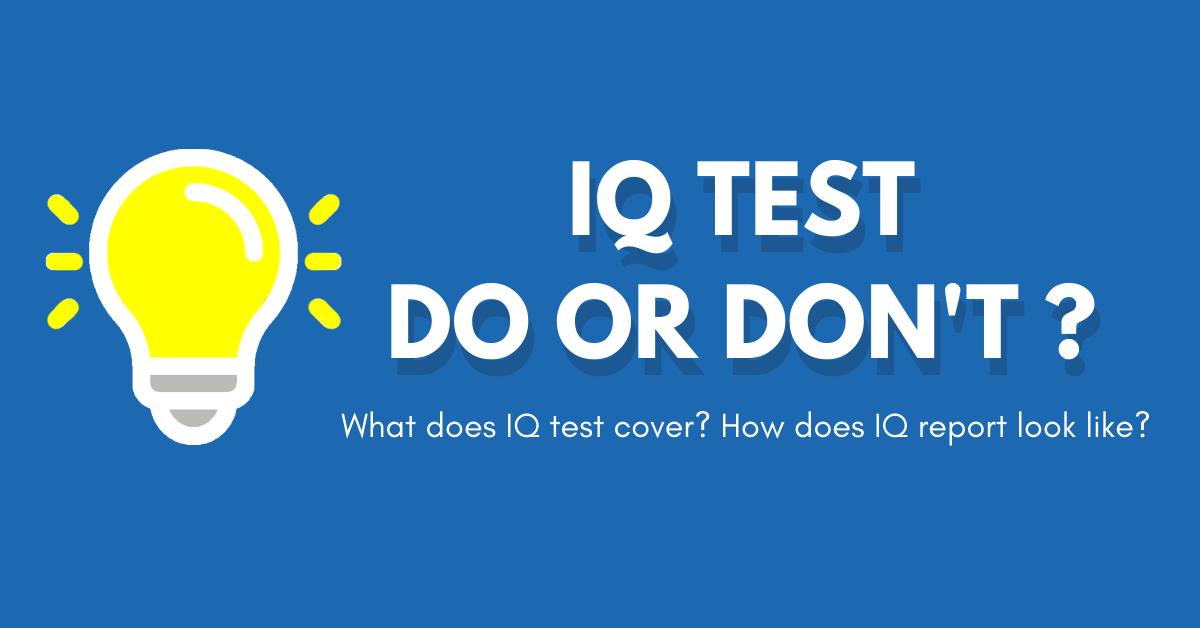
IQ Test, Do or Don't? (Part 1)
Is IQ the only sure and tangible proof of intellectual giftedness?
Many parents think the best confirmation of giftedness is through IQ (Intelligence Quotient) tests. This, however, is not completely true. While IQ tests do give a number or score to the child’s intelligence, they are not the only way of spotting a gifted child. We will discuss other more well-rounded methods of determining giftedness in our next blog, but first, let’s take a look at an overview of IQ tests.
What is an IQ test like?
There are many different types of IQ tests including Stanford-Binet, Wechsler, Woodcock-Johnson, Raven’s, Kaufman’s and others. They are based on various scales and designed by different institutions. However, the two most internationally recognised tests for children are by Stanford-Binet, known as SB-5 and Wechsler, which goes by the acronym WISC-V or WPPSI-V, which is the version used for pre-schoolers.
Stanford-Binet (SB-5)
In 1906, Lewis M. Terman, a psychologist at Stanford University developed the Binet-Simon test (Human Intelligence, 2016). This test went through a series of revisions to eventually become the Stanford-Binet Intelligence Scales. The latest version, the fifth, was revised in 2003 and is called SB-5 for short. The advisory panel for the SB5 included experts in the field of gifted education who helped design, test and eliminate or retain subtests.
The test measures five factors of cognitive ability and consists of both verbal and nonverbal subtests (Houghton Mifflin Harcourt, 2017):
- Fluid Reasoning
- Knowledge
- Quantitative Reasoning
- Visual-Spatial Processing
- Working Memory
Test results will show the Full-Scale IQ (FSIQ), nonverbal IQ (NVIQ) and verbal IQ (VIQ).
FSIQ measures general ability to reason, solve problems, and adapt to the cognitive demands of the environment. It reflects five major facets of intelligence, including reasoning, stored information, memory, visualisation, and the ability to solve original problems. The FSIQ is usually an effective predictor of long-term educational attainment, school-based achievement and vocational advancement.
Making sense of the psychologist’s report I
Here is an example (for illustration purpose) of the results of an SB-5 test done on a child, Sarah, age 4 years and 5 months:
Stanford-Binet Intelligence Scale 5th Edition (SB-5)
Index scores for Sarah at 4 years and 5 months includes:


*Standard scores have a mean of 100 and standard deviation of 15.
*A percentile signifies the percentage of score expected to fall below the reported score.
*The 95% confidence interval indicates a 95 % likelihood that an individual’s true score falls within the band of score reported.
*It’s a fictional report for illustration purpose
As can be seen from the results, Sarah’s FSIQ of 134 puts her in the 99 percentile and the `Superior-Gifted’ range.
WISC-V or WPPSI-V
Wechsler Intelligence Scale for Children or WISC-V for short is the other internationally recognised IQ test. It was developed by David Wechsler in 1949, and the latest version which was developed in 2014, is the fifth edition (hence the `V’).
Children ages two years and six months to seven years and seven months are tested with the Wechsler Preschool and Primary Scale of Intelligence (WPPSI) (Pearson, 2017).
Like SB-5, WISC-V also measures five factors:
- Verbal Comprehension Index (VCI)
- Visual Spatial Index (VSI)
- Fluid Reasoning Index (FRI)
- Working Memory Index (WMI)
- Processing Speed Index (PSI)
Each index above requires two subtests; thus, a total of 10 subtests are needed for all 5 indexes. And the Full-Scale IQ (FSIQ) is derived from 7 of the 10 subtests: Both Verbal Comprehension subtests, one Visual Spatial subtest, two Fluid Reasoning subtests, one Working Memory subtest, and one Processing Speed subtest.
In the next blog post, we will address concerns if there is a need to send your kid for an IQ test and how useful will the IQ report be. We will also be sharing some pointers you can look out for towards spotting giftedness in your kid!
Learn more about our programmes here.
